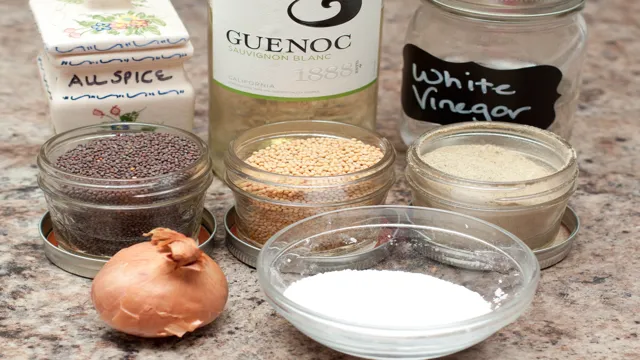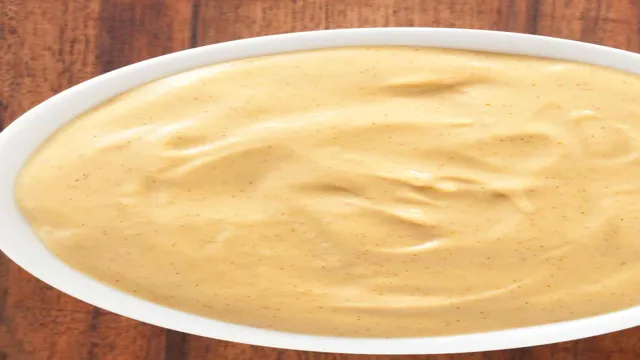If you’re looking for a new ingredient to add to your cooking arsenal, consider using Dijon mustard as a binder. This condiment is not just for spreading on sandwiches or mixing into salad dressings. Dijon mustard has a unique flavor profile that can add depth and complexity to any dish.
But what is a binder, and how does Dijon mustard function in this role? In today’s blog post, we’ll explore what a binder is and how you can use Dijon mustard to elevate your cooking game. So let’s get started!
What is a Binder?
A binder is an ingredient that helps to bind together a dish or recipe to hold it together. There are numerous types of binders and one of them is Dijon mustard. Dijon mustard is a popular condiment that can be made into a binder.
The consistency of Dijon mustard is quite thick which makes it ideal as a binder. It can be used to hold together ingredients such as bread crumbs, meats, and other similar dishes. This is especially useful for meatloaf, meatballs, and other ground meat recipes.
The tangy taste of Dijon mustard also adds a delicious flavor to the dish. So, yes, you can definitely use Dijon mustard as a binder and it will enhance the flavor of your dish.
Binder Function and Types
A binder is a crucial component of a programming language that enables you to assign values to variables within a particular context. In simple terms, it’s a mechanism that facilitates the connection between variables and their values. Binders are responsible for connecting variables to their value and specifying the scope of variables within the program.
There are different types of binders, including dynamic and static binders, which work differently. Dynamic binders are used in dynamic programming languages and associate variables with values at runtime. Static binders, on the other hand, are used in statically typed programming languages and assign variables to their values at compile time.
Understanding the different types of binders and how they work is essential for effective programming and implementing the best programming practices. So, delve into your programming language and get familiar with the binders and how they operate to improve your coding skills.

Dijon Mustard as a Binder
Yes, you can definitely use Dijon mustard as a binder when cooking. Dijon mustard contains a high amount of vinegar and oil, making it a perfect ingredient for binding other ingredients together. The vinegar helps to break down proteins in meat and fish, tenderizing and marinating them as they cook, while the oil helps to keep the ingredients moist and juicy.
When using Dijon mustard as a binder, it’s important to use just the right amount. Too little and the ingredients won’t stick together properly, but too much and you’ll end up with a bitter taste. It’s always best to start with a small amount and add more as needed, depending on your recipe and personal preferences.
So, next time you’re looking for a natural binder for your favorite dish, give Dijon mustard a try and experience its delicious flavor firsthand.
Pros and Cons
Dijon Mustard as a Binder – Pros and Cons Dijon mustard has been widely used as a binder in many different recipes due to its unique tangy flavor, and it is often used as a substitute for eggs for those with dietary restrictions. As a binder, it helps to add moisture and texture to dishes such as meatloaf, hamburgers, and vegetarian patties. However, there are both pros and cons to using Dijon mustard as a binder.
One of the primary benefits of Dijon mustard as a binder is that it adds a distinct flavor to dishes that some people find appealing. It can also be a healthy alternative to eggs and breadcrumbs, which are often high in calories and cholesterol. Additionally, it’s relatively easy to find Dijon mustard at most grocery stores, making it an accessible ingredient to use.
On the other hand, there are some disadvantages to using Dijon mustard as a binder. For example, it can overpower other ingredients, making the dish taste overwhelmingly tangy. Additionally, some people may be allergic or intolerant to mustard, making it an unsuitable ingredient for them.
Moreover, using Dijon mustard is not always a suitable replacement for eggs in recipes where eggs serve as a crucial binder. Despite the pros and cons, Dijon mustard can be an excellent choice as a binder for those who enjoy the flavor and want a healthy alternative to eggs. However, it’s essential to consider how much Dijon mustard to use to avoid overpowering the dish’s other flavors.
In summary, Dijon mustard as a binder can be an excellent choice depending on the recipe, but moderation is necessary to achieve the best results.
How to Use Dijon Mustard as a Binder
Yes, you can definitely use Dijon mustard as a binder! A binder is an ingredient that holds all the other ingredients together in a recipe. Dijon mustard is a great option for this because it has a thick consistency and a slightly acidic tang which helps to emulsify and bind ingredients. Using Dijon mustard as a binder is an easy and flavorful way to elevate the taste profile of your dish.
It works particularly well in meat dishes like burgers, meatballs, and meatloaf. Simply mix a dollop of Dijon mustard with your ground meat and other ingredients, then shape into patties or balls. The mustard helps to keep the meat moist while cooking and adds a juicy, savory flavor.
So the next time you’re wondering what to use as a binder, give Dijon mustard a try and enjoy the delicious results!
Tips and Tricks
Have you ever tried using dijon mustard as a binder for your recipes? Not only does it add a unique tangy flavor, but it can also help ingredients stick together better. To use dijon mustard as a binder, mix it with other wet ingredients like mayonnaise or honey to create a smooth and cohesive mixture. Then, add it to your ingredients and mix well.
Dijon mustard works especially well with meats like chicken or pork, as it helps to keep them moist and tender while cooking. It can also be used as a binder for vegetable dishes or salads. So next time you’re looking for a flavorful and effective binder, give dijon mustard a try!
Recipe Examples Using Dijon Mustard as a Binder
Dijon Mustard Dijon mustard is a versatile ingredient that can be used for more than just flavoring your sandwiches. It’s also an excellent binder for meatloaf recipes, and even as a marinade for grilled vegetables. When using Dijon mustard as a binder, it helps hold the ingredients together by adding moisture and a subtle tangy flavor.
To start, mix the Dijon mustard with mayonnaise and use it as a base for your meatloaf recipe instead of using eggs or breadcrumbs. Not only does this add a unique flavor, but it also ensures your meatloaf stays together. Another option is to use Dijon mustard as an ingredient in your marinade for vegetables.
The mustard acts as a glaze, and when combined with honey or maple syrup, it adds a sweet and tangy flavor that complements the grilled vegetables beautifully. Whether you’re cooking up a meatloaf or grilling up some veggies, using Dijon mustard as a binder is an easy and delicious way to elevate your dishes.
Other Alternatives to Consider
If you’re looking for an alternative to using dijon mustard as a binder, there are plenty of options to consider. One popular option is using an egg, which acts as a binding agent in many recipes. Simply beat an egg and mix it in with your ingredients to help them stick together.
Another option is using breadcrumbs, which also help to hold ingredients together. To make your own breadcrumbs, simply toast some bread and then pulse it in a food processor until it’s finely ground. Finally, you could also try using a bit of mayonnaise or Greek yogurt as a binder.
These both have a creamy texture and can help to hold ingredients together. So, while dijon mustard can be a great option for adding flavor and binding ingredients, there are definitely other options to consider if you’re out of dijon or just looking to try something new.
Exploring Other Binding Agents
When it comes to binding agents for cooking and baking, there are several alternatives to consider besides traditional eggs and wheat flour. One such alternative is the use of arrowroot powder, which is a starch-based binding agent that is derived from the arrowroot plant. It is particularly useful in gluten-free recipes as it can enhance the texture and structure of baked goods.
Another alternative is xanthan gum, which is also a popular binding agent in gluten-free recipes. It is made from fermented sugar and can be used to thicken sauces, soups, and batters. Both of these alternatives have their own unique properties and can be great options to explore for those looking to experiment with new binding agents in their cooking and baking.
Final Thoughts
When it comes to using dijon mustard as a binder, the answer is yes! Dijon mustard can be used as a flavorful and effective binder for meats, especially in dishes like meatloaf and burgers. This tangy ingredient not only adds a great depth of flavor to your dishes but also helps to hold the meat together. Simply add a dollop or two of dijon mustard to your ground meat mixture before shaping into patties or loaves.
Not only will it keep your meat moist, but it will also create a delicious crust when cooked. However, if you have guests with allergies, it’s essential to make sure that the dijon mustard you’re using doesn’t contain any ingredients that may cause an allergic reaction. Aside from that, using dijon mustard as a binder is an excellent option for any home cook looking to add a tasty twist to their meat dishes!
Conclusion
All in all, while Dijon mustard can effectively serve as a binding agent in some recipes, it’s important to remember that not all ingredients are interchangeable. Just like you wouldn’t use a hammer to screw in a nail, some recipes call for specific binding agents that shouldn’t be substituted. So, while experimenting with different ingredients and techniques can be fun and often leads to delicious discoveries, it’s important to approach cooking with a balanced mix of curiosity and caution, and to always have a backup plan in case things don’t turn out quite as expected.
Happy cooking!”
FAQs
What is a binder in cooking?
A binder is an ingredient that helps hold other ingredients together in a recipe.
Can dijon mustard be used as a binder in cooking?
Yes, dijon mustard can be used as a binder in cooking because it contains emulsifying properties that help bind ingredients together.
What other ingredients can be used as binders in cooking besides dijon mustard?
Other ingredients that can be used as binders in cooking include eggs, breadcrumbs, flour, cornstarch, and various types of sauces.
Are there any specific recipes that use dijon mustard as a binder?
Yes, dijon mustard can be used as a binder in recipes like meatloaf, burgers, and meatballs, where it helps to hold the meat and other ingredients together.
